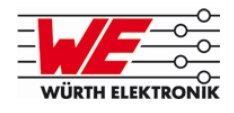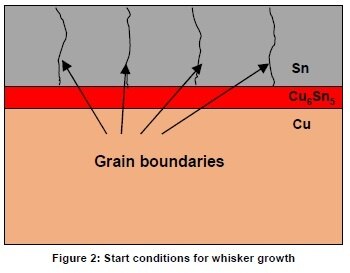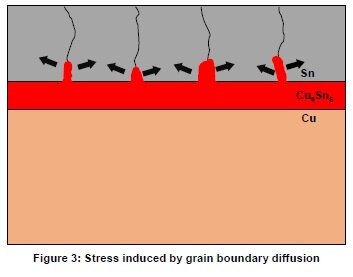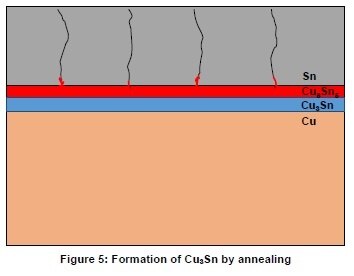WHITE PAPER
Whisker Growth and Mitigation
WPP001, BY ALFONS HARPAINTNER
1. Introduction
Several customers ask about whisker formation in our products. Below are some facts about understanding and mitigation strategies of whiskers in Würth Elektronik eiSos Group.
2. Whisker – the hidden Challenge
Whisker formation on tin-surfaces is a well known phenomenon since the early 50-ies. Although it was not well understood because when whiskers occurred the parameters as well as the test instruments were not well documented or still insufficient, this problem seemed to be solved by the use of lead additions to tin-surfaces. With new legislative actions in the European Community to avoid lead in electronic parts effective in 7/2006 (directive 2002/95/EC) the whisker problem came back. Suppliers of electronic materials (e.g. wires, lead frames) as well as the manufacturers of electronic parts had to face this challenge.
Figure 1: Whisker formation on Tin surface (reprinted with permission of NASA Electronic Parts & Packaging (NEPP) Program
2.1. Definition: What is a whisker?
It is a crystalline structure of material (hair like) with diameters of 1-10 μm (typically 1 μm) and a length of 10 μm to some mm.
Whiskers can be straight, kinked or even curved. Whiskers appear on tin surfaces and may reduce the Isolation resistance and/or the distance to adjacent parts. Additional problems arise when the whiskers break and short the printed circuit board or some fine pitch components. One of the most critical failures is a metal vapor arc at high currents and voltage.
Whisker induced failures are reported in commercial satellites, medical devices, power plants and consumer products.
Whiskers grow at different environmental conditions (temperature / moisture / pressure). They grow from the base, not from the top that means they grow out of the substrate.
2.2. Appearance: Where is the risk high?
The risk of Whisker growth is high where a copper-surface is covered with pure tin. But it is not only restricted to this combination.
Theory of Whisker Growth
The fundamental research about whisker growth is still incomplete. The common and widely accepted understanding is that whisker growth is induced by compressive forces in the tin layers.
At the interface between copper and tin even at room temperature an intermetallic layer of Cu6Sn5 will form, which is shown in figure 2.
At temperatures below 60 °C the bulk diffusion of this CuSn phase is much lower than the intergranular diffusion. So the intermetallic phase more and more fills the grain boundaries which leads to an increasing stress in the Sn grains.
The Cu6Sn5 phase needs more space than the original material and is expanding the lattice spacing (see figure 3. The change in lattice spacing is inducing compressive stress to the tin plating.
The stress is finally released when whiskers grow (starting at small defects) and a mass transport is initiated out of the tin layer.
The tin oxide, shown in figure 4, has a similar effect on top of the tin. SnO2 as well as SnO need more space than tin alone, so the humidity or corrosion taking the way down on the grain boundaries will lead to compressive stress, too.
Impurities contribute to further stress as they easily can be oxidized. So the tin plating chemistry and process will directly influence the tendency of whisker growth.
Electroplated finishes (especially "bright" finishes) therefore appear to be most susceptible to whisker formation because this process is introducing more impurities into the grains and as there are smaller grains it has also moregrain boundaries.
Last but not least the influence of externally applied compressive stress has to be considered. Bending or forming tin coated wires or lead frames (lead forming prior to mounting of an electronic component) as well as scratches or torqueing against the coated surface introduce regions of potential whisker growth.
2.3. Mitigating whisker growth
From the theories above, one can easily conclude: To avoid whisker growth it is necessary to avoid any stress on a tin plated material. The stress can be reduced by taking in account one or more of the following Guidelines.
- Avoid a big difference of the CTE (Coefficient of thermal Expansion) between plating material and substrate.
- If possible, use matte tin platings to reduce impurities and have bigger grains. For instance the carbon content of matte tin is much lower than for bright tin platings.
- Make thick electroplated Sn coatings (empirical value >10 μm) when plating directly on copper, as the induced stress will be reduced by thicker films. The bigger grains act as a damping for the forces in deeper layers. Anyway, with the formation of horizontal grain boundaries the migration of Cu to the surface areas is stopped, where the whisker are very sensitive to compressive forces.
- Avoid mechanical treatment without any further annealing. Especially compressed areas (inner side of bending) are sensitive to a whisker formation
- Make a heat treatment, within 24 h after plating, at higher temperatures >60 °C (preferred 1 h at 150 °C). A Cu3Sn layer is formed out of and below Cu6Sn5 (see figure 5). The Cu3Sn has lower molecular volume and will not add to stress in the tin layer. As the bulk diffusion is predominant in higher temperatures, a regular double layer is formed. The tendency to move into the grain boundaries is lower, as with the thickness of the barrier layers copper movement is reduced.
- Usage of a barrier layer between the copper (base material) and the tin-layer. In normal cases an electroplated nickel-layer (Würth Elektronik specification: average thickness 2 μm), which also prevents growth of Cu6Sn5 layer, is used. The hereby formed Ni3Sn has a lower molecular volume than the Cu6Sn5 leading to tensile stress which can partly compensate the compressive stress of the surrounding. The migration of copper through the blocking layer is stopped and there will be only small coper parts from the original Cu6Sn5 layer going into the grain boundaries.
- Use hot dipping of tin, which gives homogeneous layers and bigger grains. It has low level impurities and is forming stress free buildups due to the hot process. Impurities are always a center of oxidations. The lattice is disturbed in the surroundings and oxygen in combination with hydrogen can move easy along this paths inducing stress. For THT components where a solder dipping process can easily be done, this method is mostly chosen
- Silver as barrier layer between copper base material and tin top layer is also a common used method to prevent tin Whisker.
2.4. Test conditions to prove low whisker risk
There will be always small regions of stress in a layer and thus the risk for whiskers will always be there. However it is commonly agreed, that whisker growth that will saturate at a length of <50 μm within several hundreds of hours (mostly 2000 h) can be tolerated (JESD 22A121A).
In the JESD 201 recommended tests for different layers used in electronics industry can be found.
In general there are three tests that have to be done. Many companies follow these recommendations; however have modified the tests due to their components.
These 3 tests are:
a. Temperature Cycling
(-40 °C to 85 °C / 1000 cycles)
A temperature cycling is a common agreement to prove whisker “free” parts. This test accelerates the stress by thermal mismatches of the layers. For different parts and companies the lower temperatures range from -55 °C to -25 °C and cycles vary from 3 times/h to a dwell time of 30 min for each step.
b. Ambient Temperature and Humidity Storage
(30°C and RH 60% till 4000 h)
Due to the preferred gain boundary Diffusion of Cu6Sn5 at lower temperatures, storage and humidity at room temperature are increasing whisker formation. This test is often cancelled, but it is epresenting the actual conditions in the applications.
c. High Humidity and Temperature Storage
(60°C and RH 90% till 4000 h)
This is to increase the oxidation at higher temperatures. It is still in the region where whisker typically occur (-55 °C < T < 85 °C). The temperature is relative low, as higher temperatures would lead to the contradictory effect of recrystallization and stress release. However, some companies prefer to make 85 / 85 tests.
3. Whisker mitigation at WE eiSos
Würth Elektronik eiSos consequently follows the theories and recommendations above to reduce the risk of whisker formation. In addition to that, WE eiSos also does whisker tests to prove the quality for selected platings. As an example, the following pictures show an electroplated tin surface of a SMD lead with 2 μm (average) nickel underplating before and after a whisker growth test which was carried out by an external accredited lab.
As can be seen in Figure 6 and Figure 7, there was no whisker growth detected. These tests are carried out, to verify the effectiveness of the whisker mitigation strategies of Würth Elektronik eiSos.
4. Summary
Würth Elektronik eiSos has many years’ experience in passive components. The surface finishes used on the electronic components have low risk of whisker growth.
5. Literature
1) Directive 2002/96/EC of the European Parliament and of the Council of 27 January 2003 on Waste Electrical and Electronic Equipment (WEEE)
2) Directive 2002/95/EC of the European Parliament and of the Council of 27 January 2003 on the restriction of the use of certain hazardous substances in electrical and electronic equipment (RoHS)
3) C. Xu, Y. Zhang, C. Fan, and J. Abys: “Understanding Whisker Phenomenon: The Driving Force for Whisker Formation”, CircuiTree, pp. 94-105, 2002.
4) J. Smetana: ”Theory of Tin Whisker Growth “The End Game””, iNEMI Tin Whisker Workshop at ECTC, 2005, updated 2007
5) L. Panashchenko: “The Art of Metal Whisker Appreciation: A Practical Guide for Electronics Professionals”, IPC Tin Whisker Conference, 2012
6) JESD22-A121: Measuring Whisker Growth on Tin and Tin Alloy Surface Finishes, July 2004
7) JESD201: Environmental Acceptance Requirements for Tin Whisker Susceptibility of Tin and Tin Alloy Surface Finishes, 2006
8) JEDEC/IPC: JOINT PUBLICATION No. 2,”Current Tin Whiskers Theory and Mitigation Practices”, 2006
9) NASA Electronic Parts & Packaging (NEPP) Program, http://nepp.nasa.gov/whisker
IMPORTANTE NOTICE
The Application Note is based on our knowledge and experience of typical requirements concerning these areas.It serves as general guidance and should not be construed as a commitment for the suitability for customer applications by Würth Elektronik eiSos GmbH & Co. KG. The Information in the Application Note is subject to change without notice. This document and parts thereof must not be reproduced or copied without written permission, and contents thereof must not be imparted to a third party nor be used for any unauthorized purpose.
Würth Elektronik eiSos GmbH & Co. KG and its subsidiaries and affiliates (WE) are not liable for application assistance of any kind. Customers may use WE’s assistance and product recommendations for their applications and designs. The responsibility for the applicability and use of WE Products in a particular customer design is always solely within the authority of the customer. Due to this fact, it is up to the customer to evaluate and investigate, where appropriate, and decide whether the device with the specific product characteristics described in the product specification is valid and suitable for the respective customer application or not.
The technical specifications are stated in the current data sheet of the products. Therefore the customers shall use the data sheets and are cautioned to verify that data sheets are current. The current data sheets can be downloaded at www.we-online.com. Customers shall strictly observe any product-specific notes, cautions and warnings. WE reserves the right to make corrections, modifications, enhancements, improvements, and other changes to its products and services.
WE DOES NOT WARRANT OR REPRESENT THAT ANY LICENSE, EITHER EXPRESSED OR IMPLIED, IS GRANTED UNDER ANY PATENT RIGHT, COPYRIGHT, MASK WORK RIGHT, OR OTHER INTELLECTUAL PROPERTY RIGHT RELATING TO ANY COMBINATION, MACHINE, OR PROCESS IN WHICH WE PRODUCTS OR SERVICES ARE USED. INFORMATION PUBLISHED BY WE REGARDING THIRD-PARTY PRODUCTS OR SERVICES DOES NOT CONSTITUTE A LICENSE FROM WE TO USE SUCH PRODUCTS OR SERVICES OR A WARRANTY OR ENDORSEMENT THEREOF.
WE products are not authorized for use in safety-critical applications, or where a failure of the product is reasonably expected to cause severe personal injury or death. Moreover, WE products are neither designed nor intended for use in areas such as military, aerospace, aviation, nuclear control, submarine, transportation (automotive control, train control, ship control), transportation signal, disaster prevention, medical, public information network etc. Customers shall inform WE about the intent of such usage before the design-in stage. In certain customer applications requiring a very high level of safety and in which the malfunction or failure of an electronic component could endanger human life or health, customers must ensure that they have all necessary expertise in the safety and regulatory ramifications of their applications. Customers acknowledge and agree that they are solely responsible for all legal, regulatory and safety-related requirements concerning their products and any use of WE products in
such safety-critical applications, notwithstanding any applications-related information or support that may be provided by WE.
CUSTOMERS SHALL INDEMNIFY WE AGAINST ANY DAMAGES ARISING OUT OF THE USE OF WE PRODUCTS IN SUCH SAFETY-CRITICAL APPLICATIONS.
USEFUL LINKS
Application Notes: http://www.we-online.com/app-notes
REDEXPERT Design Tool: http://www.we-online.com/redexpert
Toolbox: http://www.we-online.com/toolbox
Product Catalog: http://katalog.we-online.de/en/
DIRECT LINKS
WPP001: Whisker - Growth and Mitigation
CONTACT INFORMATION
Würth Elektronik eiSos GmbH & Co. KG
Max-Eyth-Str. 1, 74638 Waldenburg, Germany
Tel.: +49 (0) 7942 / 945 – 0
Email: appnotes@we-online.de








Top Comments